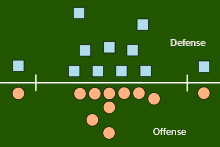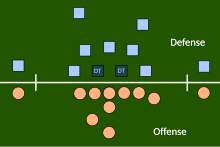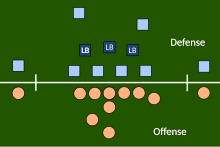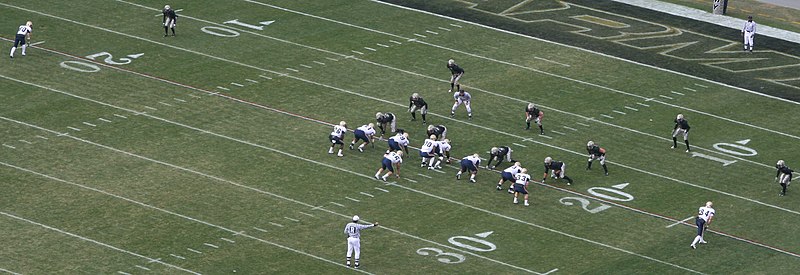How To Beat A 4 3 Defense

In American football, a 4–three defense is a defensive alignment consisting of four downwardly linemen and three linebackers. It is called a "base of operations defense" because it is the default defensive alignment used on "base downs" (1st and 2d downs). Notwithstanding, defenses will readily switch to other defensive alignments (such every bit a nickel defence or a dime defense) as circumstances change. Alternatively, some defenses use a iii–4 defense force.
History [edit]
The Giants employed a 6–1–4 basic formation when they shut out the Browns in 1950, but on many plays this became a 4–ane–half-dozen in reality, when the brawl was snapped, because the ends dropped off the line to afford boggling coverage on passes
—Steve Owen, My Kind of Football, 1952, p. 183
Early in the history of the NFL, teams stacked the defensive line of scrimmage with 7 linemen, typically using a vii-diamond or the 7-box.[i] With the liberalization of the forwards passing rules in 1933, the defenses began to evolve along with the offensive changes, and past the afterward 1930s, the standard defence force in the NFL and college was the 6–2.[2] [3] The successes of the T formation and the introduction of free commutation (abolishing the ane-platoon system) in the 1940s led to the about universal adoption by 1950 of the five-man line.[4] In that location were two versions popular in the NFL. The 5–3 was an older defense that remained pop through the 1940s and early 1950s.
By the late 1940s, Greasy Neale's v–ii Eagle defense was creating issues for offenses with a 5-human being line and four-human secondary. Roughly concurrently, Paul Brown had developed a vertical timing offense. The Browns won every championship of the rival All-America Football game Conference from its inception in 1946 through its terminal season in 1949. In the offset game of the 1950 flavour, NFL Commissioner Bert Bell had the newly admitted Browns play the champion Philadelphia Eagles on a Saturday ahead of the rest of the league's scheduled Sunday games. The Browns handily won the game in Philadelphia 35–ten and showed they were a forcefulness to be reckoned with.
Defenses knew they had to discover a style to stop the spread-out vertical criminal offense of the Browns. New York Giants head passenger vehicle Steve Owen came up with his umbrella defense which showed a vi–1–4 alignment before the snap only could flex (drop back) its two defensive ends into pass protection. The defense was successful, and the only ii losses by the Browns in 1950 came at the hands of the Giants. While the concept belonged to Owen, the newly acquired defensive back, Tom Landry, explained and taught the defence.[5] While the defense force was a forerunner to the traditional four–3–iv of today, information technology was not yet evolved into what one would call a traditional 4–3 defense. That took an additional six years.
Other NFL teams came to a version of the iv–3 via a unlike route. Despite the success of the Browns in the unmarried game with the Eagles, the v–two Eagle became more than popular, and more teams began to switch to information technology from the older 5–iii defense.[four] Considering the 5–2 lacks a center linebacker, it was vulnerable to passes over the middle. As a consequence, 5–2 teams experimented with pulling their middle guards back, and many teams were trying this new approach by 1954.[6] In 1956, Landry became the first defensive coordinator to switch to the 4–3 as a base defence force. As the 1956 Giants won the NFL Championship, this gave the four–three enormous exposure, and simply about the whole NFL converted to the new system the following flavour.[six]
In the original version of the 4–three, the tackles lined upward over the offensive guards and the ends lined up on the exterior shoulder of the offensive tackles, with the centre linebacker over the middle and the other linebackers outside the ends. In the mid-1960s, Hank Stram adult a pop variation, the "Kansas City Stack", which shifted the strong-side defensive finish over the tight stop, stacked the stiff-side linebacker over the tackle, and shifted the weak-side tackle over center. At about the same time, the Cleveland Browns frequently used a weak-side shift. Landry developed a "flex" variation, in order to accept advantage of the quickness of his Hall of Fame tackle, Bob Lilly.[7] In Landry's original 4–iii defenses (four–iii inside and 4–iii outside), both defensive tackles were flexed.[8] In the "flex", on a pro set right, with defensive keys showing a run to the right, the right defensive tackle would exist affluent on the line and was supposed to penetrate.[nine] The correct defensive end and left defensive tackle were flexed 2 feet off the line of scrimmage, the right defensive terminate now head-on with the left offensive tackle (i.e. a 4–2–2–5 front instead of the more common 5–2–2–v front). This gave the defense a "zig zag" look dissimilar any other of its day. The 'flex' was developed to counter option blocking by the offensive lines which had learned to move their heads up defensive linemen to either side to create holes. The running back would and then patiently run to daylight. The Flex allowed two defensive linemen to read and react improve to the option blocking. The other two linemen could either assault upfield or hold their single gap like the flexed linemen and expect for the ball to come to them. These concepts of shooting the gap and shoot and concord the gap are integral parts of today's more modernistic versions of the four–3 which include the Tampa 2 scheme, the Seattle Seahawks shoot and hold defense and the 4–3 slide.
Defensive line [edit]

Two defensive tackles split the heart in the base four–3 defence force.
- Defensive tackles
There are ii defensive tackles in the iv–3 scheme. Teams whose base front is an "over" or "under" front will have a nose tackle in this scheme. In schemes whose base gear up is an even 4–3, in that location is no olfactory organ tackle. Instead, there is a left and right defensive tackle. When teams do not accept a nose tackle, the tackles line up face on the offensive guards. The nose tackle is by and large slightly larger and stronger and plays a shade or head-up technique in which he lines upwards on either the outside shoulder of the eye or in the middle of his body depending on which way the strength of the play is going. The nose tackle'southward chief job is to stop the run and take on the double squad (which is getting blocked by both the center and the weak-side or pulling guard) thus freeing up the linebackers to make a play. The 2nd defensive tackle (just referred to as the defensive tackle, nether tackle or three tech) is generally a bit quicker and faster than the nose tackle, ideally weighing close to 300 pounds (140 kg) just quick-footed plenty to shoot through a gap at the snap.[10] He plays a iii technique, meaning he lines up on the outside shoulder of the strong side offensive guard. The job of a three tech is to forbid the run, keep the guard off linebackers, and blitz the quarterback on pass plays.

The defensive ends flank the tackles.
- Defensive ends
Teams that want to utilize a standard 4–3 scheme oft face a dilemma: there aren't enough cracking defensive ends to go around. Players like Julius Peppers or Dwight Freeney come up along almost one time per year in the draft.
The defensive stop'south primary role in the 4–3 defense is to get to the quarterback and create force per unit area. The 4–3 DEs are the smallest of all of the defensive lineman due to their emphasis on speed over strength. They still need to be strong enough to fight their way past offensive tackles, yet quick enough to pursue the running backs on runs to the outside. Ideal 4–3 defensive ends are able-bodied and agile and their strength is getting upward the field speedily and they usually weigh between 265 and 295 pounds (120 and 134 kg).[11] Right ends, who line upwardly against the offensive left tackle and attack from the blind side of a right-handed quarterback, are unremarkably the best athletes on the line, combining a 275-pound body with quickness and agility to outflank blockers who are bigger and heavier.[x] Defensive ends mostly play the 1 gap technique, though will occasionally be forced to play a ii gap in the upshot of a TE pinching in to block on run plays. In nearly schemes, they are also responsible for keeping the quarterback from rolling out of the pocket to make big running gains.
- Variant
Some teams, similar the Seattle Seahawks, Denver Broncos, Cincinnati Bengals and Las Vegas Raiders, use an alternative sort of the 4–3 defense force. They like to utilise a big, stiff, 280-plus-pound stiff-side defensive finish to stop the run on their base formation, and on passing downs they boot inside at defensive tackle to insert a pass rush specialist. But players like Von Miller, an aristocracy and undersized defensive end, play strong-side linebacker on first and 2d downs and use their pass-rushing ability on passing downs by lining up at stand-up defensive terminate to bring pressure on the quarterback.
Linebackers [edit]

Linebackers in the 4–3 base of operations defence force
- Center linebacker
At that place is only i inside linebacker in the 4–iii scheme, so he is chosen the middle linebacker (MLB), sometimes known as the "Mike" linebacker. He must exist as smart as he is athletic, acts as the "quarterback of the defense" and is ofttimes the defensive leader.[x] The primary responsibility of the "Mike" is to cease the run, though he will frequently be asked to fall dorsum in zone coverage in laissez passer protection; human to human being pass coverage has him assigned to the fullback typically. The MLB is frequently the largest and strongest of all of the linebackers.
The 4–three defense force relies on having a sure tackler at the eye linebacker spot. Nigh notably, Monte Kiffin's "Tampa Cover 2" scheme makes loftier demands on the MLB, requiring him to have in a higher place-average speed, and additional skills to exist able to read the play and either maintain his primal position to aid the outside linebackers encompass short passes, drop behind the linebackers in coverage and protect the zone of the field behind the exterior linebackers from 11 to xx yards out, or run up to the line of scrimmage to help assist in stopping the runs. Luke Kuechly and Brian Urlacher were prototypical "Mike" linebackers before retirement.
- Outside linebackers
As in the 3–iv defense in that location are two outside linebackers in the 4–3. These exterior backers are known as the strong-side and weak-side linebackers. The strong-side, or "Sam" linebacker, is so named considering he typically sticks to the strong side of the defense, across from the tight end. The "Sam" does his fair share of blitzing; however, he also needs to play the run and take on blockers, making him a bigger linebacker on average than the weak-side linebacker. He will unremarkably exist relied upon to comprehend the tight finish or potentially a back out of the backfield.[12] Anthony Barr is a prototypical "Sam" linebacker. The weak-side, or "Will" linebacker, will generally play on the weak side and has more freedom than the other LBs, frequently blitzing the quarterback or guarding against the screen. He also has heavy coverage responsibilities, making a skilful number of today's Volition linebackers old safeties.[xiii] Lavonte David is a prototypical "Will" linebacker.
Secondary [edit]
The iv–3 defence generally uses iv defensive backs. Two of these are safeties, and two of them are cornerbacks. A cornerback's responsibilities vary depending on the type of coverage called.
Coverage is simply how the defense will be protecting against the pass. The corners volition generally line up 3 to five yards off the line of scrimmage, generally trying to "Jam" or interrupt the receiver's route within the beginning five yards. A corner will be given one of two means to defend the pass (with variations that effect in more or less the same responsibilities): zone and human-to-man. In zone coverage, the cornerback is responsible for an area on the field. In this instance, the corner must always stay downfield of whomever he is covering while however remaining in its zone. Zone is a more than relaxed defensive scheme meant to provide more than awareness across the defensive secondary while sacrificing tight coverage. As such, the corner in this case would be responsible for making sure nobody gets exterior of him, always, or downfield of him, in cases where there is no deep prophylactic assist. In human coverage, however, the cornerback is solely responsible for the man beyond from him, usually the offensive player dissever farthest out.
The complimentary safe is responsible for reading the offensive plays and covering deep passes. Depending on the defensive telephone call, he may also provide run support. He is positioned 10 to 15 yards behind the line of scrimmage, toward the middle of the field. He provides the last line of defense against running backs and receivers who get past the linebackers and cornerbacks. He must be a quick and smart player, capable of making tackles efficiently likewise equally reading the play and alerting his team of game situations. The strong prophylactic is usually larger than the free safety and is positioned relatively close to the line of scrimmage. He is frequently an integral role of the run defense, but is also responsible for defending confronting a pass; especially against passes to the tight-ends.
Teams currently deploying the 4–iii defense [edit]
NFL teams that utilise the iv–3 defense as of 2022 include the Washington Commanders, New York Jets, Chicago Bears, Cincinnati Bengals, Cleveland Browns, Buffalo Bills, Philadelphia Eagles, New Orleans Saints, San Francisco 49ers, Indianapolis Colts, Carolina Panthers and Kansas Urban center Chiefs. The Philadelphia Eagles returned to running a 4–three defense force for the 2016 season, after switching to the iii–4 at the kickoff of 2013. The New York Jets used variations of the iv–3 for the 2012 NFL flavor confronting spread offenses, but volition stick with the 3–4 defence force as its base. The Patriots run a hybrid defense force including elements from both the 4–three, and iii–iv defense.[14]
Beginning in 2017, the San Francisco 49ers switched from a 3–4 to a iv–3 defense with the hiring of head autobus Kyle Shanahan and defensive coordinator Robert Saleh.
The Cardinals will return to the 3–4 under new defensive coordinator Vance Joseph in 2019. Arizona ran the three–4 nether coordinators Todd Bowles and James Bettcher from 2013 to 2017.
The Kansas City Chiefs switched to a hybrid four–iii defence in the 2019 flavour,[15] with the hiring of new defensive coordinator Steve Spagnuolo.
The Vikings have run the 4–3 continuously since 1986, the longest current run in the NFL. All the same, new head passenger vehicle Kevin O'Connell has announced that the Vikings will revert to the iii–four in 2022 under new defensive coordinator Ed Donatell. Minnesota briefly switched to the 3–iv from 1982 to 1985 before jitney Jerry Burns and defensive coordinator Floyd Peters returned to the base defense in which the Purple People Eaters of the 1970s flourished.
The Tampa Bay Buccaneers switched to a iii–4 defence force in the 2019 season under then defensive coordinator, Todd Bowles, who previously ran the 3–4 defence force with the New York Jets.
The Carolina Panthers switched to a 3–4 base of operations defence in the 2019 season for the commencement fourth dimension since the late 1990s.
Beginning in the 2020 season, the Washington Commanders volition return to the 4–3 base defence force for the beginning fourth dimension since 2009 under new head coach Ron Rivera and new defensive coordinator Jack Del Rio.
In 2020, the Dallas Cowboys switched to a base three–4 defense. This was reverted in 2021 after their 2020 defense allowed a franchise-record 473 points.
With the hiring of Robert Saleh as head coach, the New York Jets will switch to a 4–three defense in 2021, merely volition have a few 3–4 looks.

Army'southward defense force (in black) is lined upwards in a base iv–three set up against the Navy's offense in the 2008 Army–Navy Game.
References [edit]
- ^ Owen, Steve, p. 177
- ^ Halas, pp. 167–170
- ^ Owen, Steve, pp. 178–179
- ^ a b Full Football II, chapter 17.
- ^ Tom Landry: an Autobiography ISBN 0310529107
- ^ a b Zimmerman, p. 128
- ^ Golenbock, p. 233
- ^ Lombardi, pp. 173–185
- ^ Golenbock, pp. 232–240.
- ^ a b c d Tanier, Mike (2006-08-28). "The four–iii vs. the 3–four". NFL on Play tricks. Archived from the original on 2009-04-15.
- ^ Smith, Michael (2004-12-15). "Defensive linemen do the dirty work in 3–4". ESPN.com.
- ^ Miller, Matt. "Football 101: Linebacker Assignments and Alignment". Bleacher Report.
- ^ "Football 101: Players and Positions". football game.calsci.com.
- ^ The Essential Faces of the New England Patriots Defensive Front end The Football Educator.
- ^ "Kansas Metropolis Chiefs: How transition to four–3 affects hereafter of Chiefs defense". Feb 11, 2019.
Bibliography [edit]
- Carroll, Bob, Gershman, Michael, Neft, David, and Thorn, John, Full Football II: The Official Encyclopedia of the National Football League, Harper Collins, 1999, Chapter 17.
- Halas, George, Morgan, Gwen, and Veysey, Arthur, Halas past Halas, McGraw-Loma, 1979.
- Lombardi, Vince, Vince Lombardi on Football game, New York Graphic Order, 1973.
- Owen, Steve, My Kind of Football game, David McKay, 1952.
- Golenbock, Peter, Cowboys Take Always Been my Heroes, Warner Books, 1997, Chapter 20.
- Zimmerman, Paul, The New Thinking Man's Guide to Pro Football, Simon and Schuster, 1984, Chapter half dozen.
- Piascik, Andy, The All-time Evidence in Football game: The 1946–1955 Cleveland Browns – Pro Football game's Greatest Dynasty, Taylor Trade Publishing, 2006 [ebook]
External links [edit]
- 1989 Monte Kiffin 4–3 Defense
- 1992 Dallas Cowboys 4–3 Defense
- 1994 Arizona Cardinals 4–3 Defence force
Source: https://en.wikipedia.org/wiki/4%E2%80%933_defense

0 Response to "How To Beat A 4 3 Defense"
Post a Comment